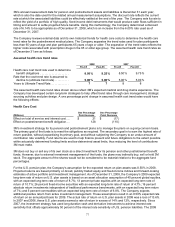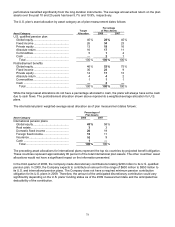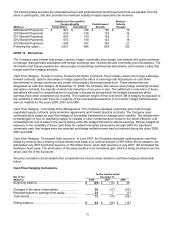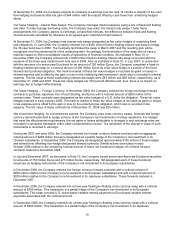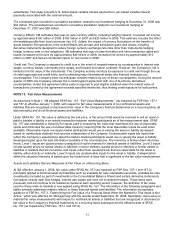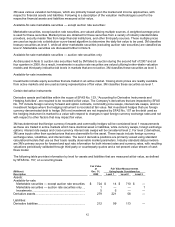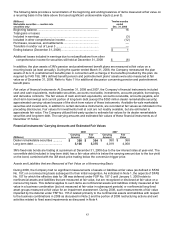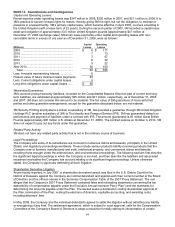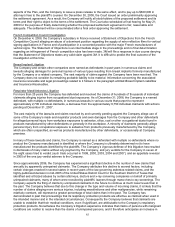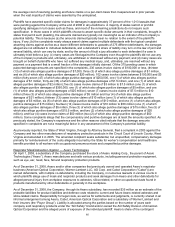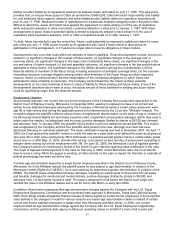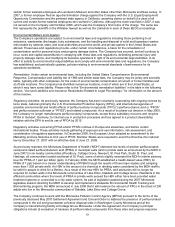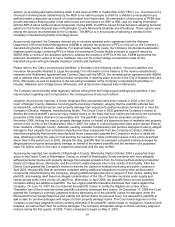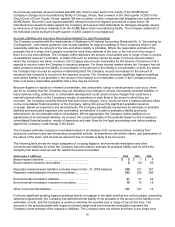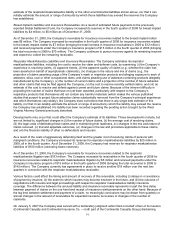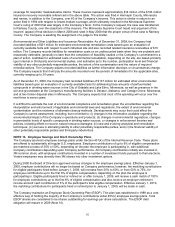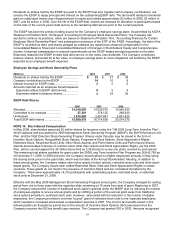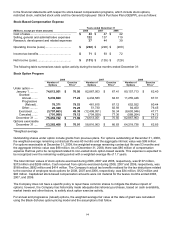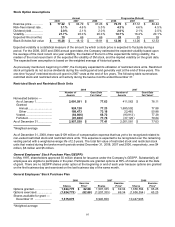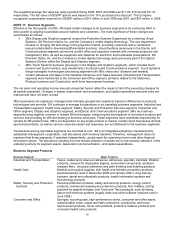3M 2008 Annual Report Download - page 92
Download and view the complete annual report
Please find page 92 of the 2008 3M annual report below. You can navigate through the pages in the report by either clicking on the pages listed below, or by using the keyword search tool below to find specific information within the annual report.
86
the average cost of resolving pending and future claims on a per-claim basis than it experienced in prior periods
when the vast majority of claims were asserted by the unimpaired.
Plaintiffs have asserted specific dollar claims for damages in approximately 37 percent of the 1,013 lawsuits that
were pending against the Company at the end of 2008 in all jurisdictions. A majority of states restrict or prohibit
specifying damages in tort cases such as these, and most of the remaining jurisdictions do not require such
specification. In those cases in which plaintiffs choose to assert specific dollar amounts in their complaints, brought in
states that permit such pleading, the amounts claimed are typically not meaningful as an indicator of the Company’s
potential liability. This is because (a) the amounts claimed typically bear no relation to the extent of the plaintiff’s
injury, if any; (b) the complaints nearly always assert claims against multiple defendants with the typical complaint
asserting claims against as few as a dozen different defendants to upwards of 275 different defendants, the damages
alleged are not attributed to individual defendants, and a defendant’s share of liability may turn on the law of joint and
several liability, which can vary by state, and by the amount of fault a jury allocates to each defendant if a case is
ultimately tried before a jury; (c) many cases are filed against the Company even though the plaintiffs did not use any
of the Company’s products and, ultimately, are withdrawn or dismissed without any payment; and (d) many cases are
brought on behalf of plaintiffs who have not suffered any medical injury, and, ultimately, are resolved without any
payment or a payment that is a small fraction of the damages initially claimed. Of the 375 pending cases in which
purported damage amounts are specified in the complaints, 230 cases involve claims of $100,000 or less, (thirteen
(13) of which also alleges punitive damages of $7,000, three (3) of which also allege punitive damages of $1 million,
and six (6) of which also allege punitive damages of $20 million); 102 cases involve claims between $100,000 and $3
million (forty-seven (47) of which also allege punitive damages of $250,000, one (1) of which also alleges punitive
damages of $1 million, thirty-six (36) of which also allege punitive damages of $1.5 million, and one (1) of which also
alleges punitive damages of $2 million); five (5) cases involve claims of $3 million to $7.5 million (one (1) of which
also alleges punitive damages of $350,000, one (1) of which also alleges punitive damages of $5 million, and one
(1) of which also alleges punitive damages of $25 million); seven (7) cases involve claims of $7.5 million to $10
million (three (3) of which also allege punitive damages of $5 million and four (4) of which also allege punitive
damages of $21 million); thirteen (13) cases involve claims of $10 million (one (1) of which also alleges punitive
damages of $5 million, six (6) of which also allege punitive damages of $10 million, and one (1) of which also alleges
punitive damages of $15 million); fourteen (14) cases involve claims of $10 million to $50 million (one (1) of which
also alleges punitive damages of $5 million, three (3) of which also allege punitive damages of $15 million, five (5) of
which also allege punitive damages of $15.5 million, and two (2) of which also allege punitive damages of $20
million); and four (4) cases involve claims of $50 million (two (2) of which also allege punitive damages of $50
million). Some complaints allege that the compensatory and punitive damages are at least the amounts specified. As
previously stated, the Company’s experience and the other reasons cited indicate that the damage amounts
specified in complaints are not a meaningful factor in any assessment of the Company’s potential liability.
As previously reported, the State of West Virginia, through its Attorney General, filed a complaint in 2003 against the
Company and two other manufacturers of respiratory protection products in the Circuit Court of Lincoln County, West
Virginia and amended it in 2005. The amended complaint seeks substantial, but unspecified, compensatory damages
primarily for reimbursement of the costs allegedly incurred by the State for worker’s compensation and healthcare
benefits provided to all workers with occupational pneumoconiosis and unspecified punitive damages.
Respirator Mask/Asbestos Litigation — Aearo Technologies
On April 1, 2008, a subsidiary of the Company purchased the stock of Aearo Holding Corp., the parent of Aearo
Technologies (“Aearo”). Aearo manufactures and sells various products, including personal protection equipment,
such as eye, ear, head, face, fall and respiratory protection products.
As of December 31, 2008, Aearo and/or other companies that previously owned and operated Aearo’s respirator
business (American Optical Corporation, Warner-Lambert LLC, AO Corp. and Cabot Corporation (“Cabot”)) are
named defendants, with multiple co-defendants, including the Company, in numerous lawsuits in various courts in
which plaintiffs allege use of mask and respirator products and seek damages from Aearo and other defendants for
alleged personal injury from workplace exposures to asbestos, silica-related, or other occupational dusts found in
products manufactured by other defendants or generally in the workplace.
As of December 31, 2008, the Company, through its Aearo subsidiary, has recorded $35 million as an estimate of the
probable liabilities for product liabilities and defense costs related to current and future Aearo-related asbestos and
silica-related claims. Responsibility for legal costs, as well as for settlements and judgments, is currently shared in an
informal arrangement among Aearo, Cabot, American Optical Corporation and a subsidiary of Warner Lambert and
their insurers (the “Payor Group”). Liability is allocated among the parties based on the number of years each
company sold respiratory products under the “AO Safety” brand and/or owned the AO Safety Division of American
Optical Corporation and the alleged years of exposure of the individual plaintiff. Aearo’s share of the contingent



